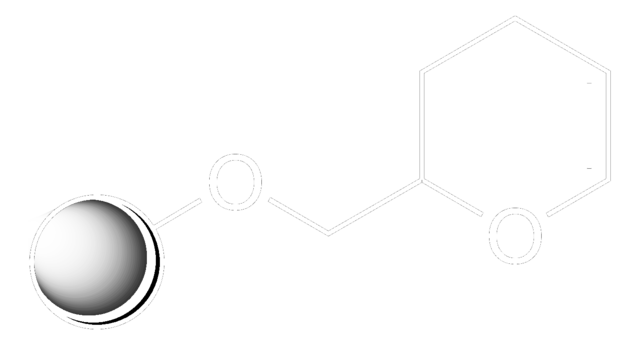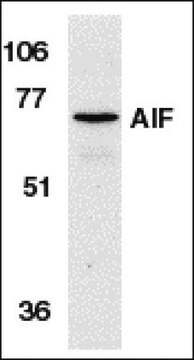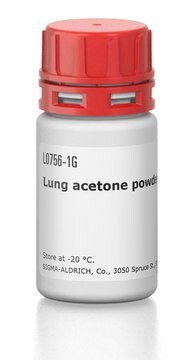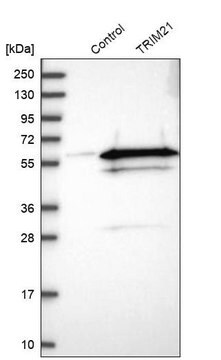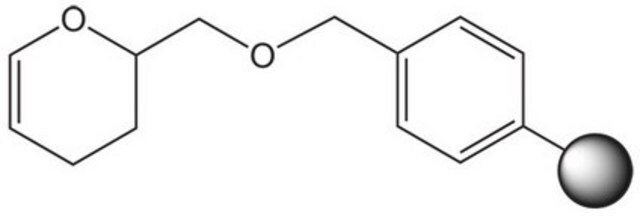추천 제품
생물학적 소스
rabbit
Quality Level
항체 형태
purified immunoglobulin
항체 생산 유형
primary antibodies
클론
polyclonal
종 반응성
human, mouse, rat
제조업체/상표
Chemicon®
기술
immunohistochemistry: suitable (paraffin)
western blot: suitable
NCBI 수납 번호
UniProt 수납 번호
배송 상태
wet ice
타겟 번역 후 변형
unmodified
유전자 정보
human ... AIFM1(9131)
일반 설명
Apoptosis is characterized by several morphological nuclear changes including chromatin condensation and nuclear fragmentation. These changes are triggered by the activation of members of the caspase family, caspase activated DNase, and several novel proteins (Zamzami et al., 1999). A novel gene, the product of which causes chromatin condensation and DNA fragmentation, was recently identified, cloned, and designated apoptosis inducing factor (AIF) (Susin et al., 1999). Like the critical molecules, cytochrome c and caspase 9, in apoptosis, AIF localizes in mitochondria. AIF translocates to the nucleus when apoptosis is induced and induces mitochondria to release the apoptogenic proteins, cytochrome c and caspase-9. AIF induces chromatin condensation and DNA fragmentation, which are the hallmarks of apoptosis, of the isolated nucleus and the nucleus in live cells by microinjection. AIF is highly conserved between human and mouse and widely expressed (Susin et al., 1999).
특이성
Apoptosis is characterized by several morphological nuclear changes including chromatin condensation and nuclear fragmentation. These changes are triggered by the activation of members of the caspase family, caspase activated DNase, and several novel proteins (Zamzami & Kroemer 1999). A novel gene, the product of which causes chromatin condensation and DNA fragmentation, was recently identified, cloned, and designated apoptosis inducing factor (AIF) (Susin et al. 1999). Like the critical molecules, cytochrome c and caspase 9, in apoptosis, AIF localizes in mitochondria. AIF translocates to the nucleus when apoptosis is induced and induces mitochondria to release the apoptogenic proteins, cytochrome c and caspase-9. AIF induces chromatin condensation and DNA fragmentation, which are the hallmarks of apoptosis, of the isolated nucleus and the nucleus in live cells by microinjection. AIF is highly conserved between human and mouse and widely expressed (Susin et al. 1999).
면역원
Epitope: internal domain
Rabbit anti-AIF (Internal region) polyclonal antibody was raised against a peptide corresponding to amino acids 517 to 531 of human AIF (Susin et al. 1999). This sequence is identical to those of mouse and rat AIF (Susin et al. 1999).
애플리케이션
Anti-AIF Antibody, internal domain is an antibody against AIF for use in IH(P) & WB.
Research Category
Apoptosis & Cancer
Apoptosis & Cancer
Research Sub Category
Apoptosis - Additional
Apoptosis - Additional
Western blot: 0.25 to 1 μg/mL.
K562 cell lysate can be used as a positive control and a 67 kDa band should be detected.
Immunohistochemistry on formalin fixed, paraffin sections: 5-20 μg/ml, with antigen retrieval; see website protocol for details and photographs.
Optimal working dilutions must be determined by end user.
K562 cell lysate can be used as a positive control and a 67 kDa band should be detected.
Immunohistochemistry on formalin fixed, paraffin sections: 5-20 μg/ml, with antigen retrieval; see website protocol for details and photographs.
Optimal working dilutions must be determined by end user.
표적 설명
67 kDa
결합
Replaces: 04-430
물리적 형태
Ammonium sulfate precipitation and DEAE-cellulose chromatography
Format: Purified
Purified IgG in PBS containing 0.02% sodium azide.
저장 및 안정성
Maintain for 1 year at 2–8°C from date of shipment. For maximum recovery of product, centrifuge the original vial after thawing and prior to removing the cap.
분석 메모
Control
Widely expressed
Widely expressed
기타 정보
Concentration: Please refer to the Certificate of Analysis for the lot-specific concentration.
법적 정보
CHEMICON is a registered trademark of Merck KGaA, Darmstadt, Germany
면책조항
Unless otherwise stated in our catalog or other company documentation accompanying the product(s), our products are intended for research use only and are not to be used for any other purpose, which includes but is not limited to, unauthorized commercial uses, in vitro diagnostic uses, ex vivo or in vivo therapeutic uses or any type of consumption or application to humans or animals.
적합한 제품을 찾을 수 없으신가요?
당사의 제품 선택기 도구.을(를) 시도해 보세요.
Storage Class Code
10 - Combustible liquids
WGK
WGK 2
Flash Point (°F)
Not applicable
Flash Point (°C)
Not applicable
시험 성적서(COA)
제품의 로트/배치 번호를 입력하여 시험 성적서(COA)을 검색하십시오. 로트 및 배치 번호는 제품 라벨에 있는 ‘로트’ 또는 ‘배치’라는 용어 뒤에서 찾을 수 있습니다.
Carlo Rinaldi et al.
American journal of human genetics, 91(6), 1095-1102 (2012-12-12)
Cowchock syndrome (CMTX4) is a slowly progressive X-linked recessive disorder with axonal neuropathy, deafness, and cognitive impairment. The disease locus was previously mapped to an 11 cM region at chromosome X: q24-q26. Exome sequencing of an affected individual from the
Alfredo Criollo et al.
Apoptosis : an international journal on programmed cell death, 12(1), 3-18 (2006-11-03)
HeLa and HCT116 cells respond differentially to sorbitol, an osmolyte able to induce hypertonic stress. In these models, sorbitol promoted the phenotypic manifestations of early apoptosis followed by complete loss of viability in a time-, dose-, and cell type-specific fashion
Loss of Aif function causes cell death in the mouse embryo, but the temporal progression of patterning is normal.
Brown, D; Yu, BD; Joza, N; Benit, P; Meneses, J; Firpo, M; Rustin, P; Penninger, JM; Martin, GR
Proceedings of the National Academy of Sciences of the USA null
P2X7 receptor differentially modulates astroglial apoptosis and clasmatodendrosis in the rat brain following status epilepticus.
Ji-Eun Kim,Hea Jin Ryu,Seong-Il Yeo,Tae-Cheon Kang
Hippocampus null
Acyl coenzyme A-binding protein augments bid-induced mitochondrial damage and cell death by activating mu-calpain.
Shulga, N; Pastorino, JG
The Journal of Biological Chemistry null
자사의 과학자팀은 생명 과학, 재료 과학, 화학 합성, 크로마토그래피, 분석 및 기타 많은 영역을 포함한 모든 과학 분야에 경험이 있습니다..
고객지원팀으로 연락바랍니다.